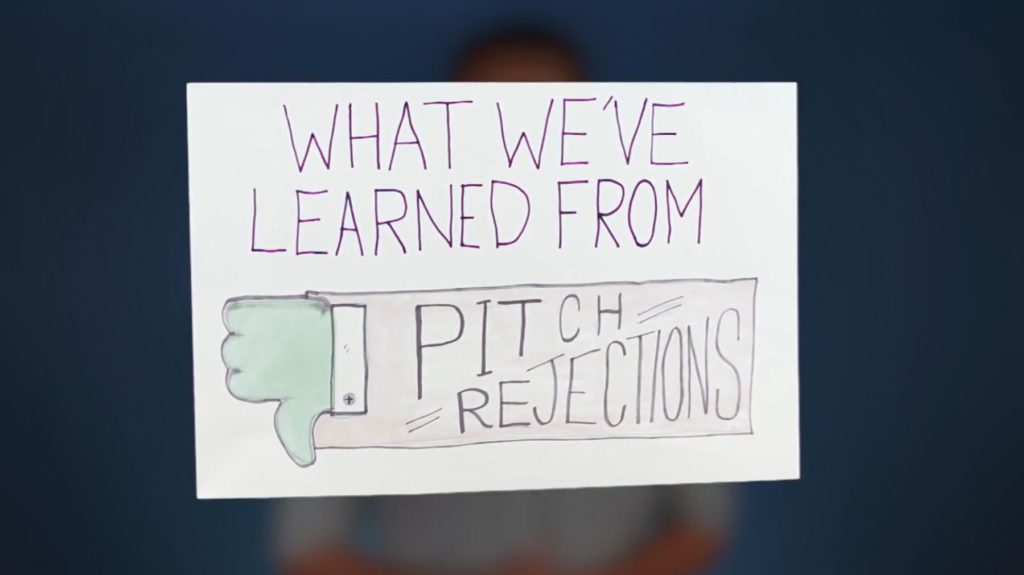It’s hard to not feel hurt from rejections, because, well, no one likes to get rejected.
And when you’re in the creative world, rejections are a part of life.
They say, “Sorrow shared is half the sorrow,” so here are some examples of when an idea we loved didn’t make it past the pitch deck, and what we did to move forward.
Pitch Fail #1: We Went Retro
Vintage is always in style, but it doesn’t always make sense for a video to reflect on past trends…especially when your client is solving problems in new ways.
Regardless of being a startup or in the technology industry, everyone is working towards solving problems that don’t exist yet, so it’s important to be future thinking when scoping out video ideas. Just because something is cool, doesn’t mean it’s a perfect fit.
Real Life Example: we once pitched a retro theme to a financial services company. We liked the style of old educational videos with a scratchy 1950s voiceover to directly teach and play around with nostalgia.
This doesn’t mean you can’t mention antiqued technologies or old-fashioned trends, but you need to write your story to show how the client has moved the world from that into the future. Just check out our Bionic marketing video series to see how much the advertising world has changed since the Mad Men era.
What did we learn?
To remind ourselves of two things when coming up with video ideas:
One, that associations are powerful, viewers make them in microseconds. Always be thinking of what connotations viewers could be making when watching your marketing video and plan accordingly.
And two, be visionary. Your client is solving future problems, your work should help them do so.
Pitch Fail #2: We Mixed Up The Metaphor
“Now, stick with us here, but imagine your polar bear mascot in the Wild West.” – Us pitching an idea.
Metaphors are great storytelling devices, but when used incorrectly, can really miss the mark. It can confuse the messaging, mess with brand identity and awareness, and generally be too far reaching and people will have a hard time making the connection.
It can be hard to relinquish a metaphor, especially when it basically writes itself…
Real Life Example: We weren’t kidding when we said we should put an Arctic animal in the desert. Using a Wild West as a backdrop would help make the writing easy and the animation fun, but having a cold-weather animal in a not-so-cold place was just confusing in the end.
“Standing off with competitors,” “Dueling for viewer’s attention,” “Quick draw solution,” it took seconds to come up with those examples and when you’re busy with projects, it can be tempting to give in. However, as with most of life, the simplest answer isn’t always the best and you have to dig a little deeper to come up with the next great idea.
What did we learn?
That if there isn’t a strong metaphor that comes to mind right away, don’t force it, and reevaluate what storytelling techniques are appropriate.
Pitch Fail #3: We Went with the Wrong Tone
Cuteness. Humor. Whimsy. They’re great for writing and coming up with great storylines, but depending on the video’s purpose, it isn’t always the best choice.
It’s important to think of your audience. Do they need authority? Validation? Evidence?
Sometimes the opposite is true. It’s possible to come off too strong, unagreeable, or abrasive when being assertive or bold. Humor can be great for talking about difficult or boring subjects and whimsy can help with aspirational videos (which can be great for nonprofits).
The tone is all about who you’re talking to and what you want to them to learn from your marketing video. If you’re not speaking in their language, per se, you’ll never be able to get your message across effectively.
Real Life Example: for a real estate company marketing video, we wanted to play around with the idea of competitiveness in the field, but in the end, the tone was too confrontational and the audience would be left feeling stressed out.
What did we learn?
During the creative brief, we always ask what the target audience is so we understand it from the get-go and don’t make the same mistake twice.
How does this make you feel, Demo Duck?
So how do we handle the rejection?
We love it! We learn something new every time.
In our own internal work, we don’t grow attached to certain ideas and challenge ourselves to think more boldly. New ideas will always come. We have an open brainstorm where everyone can share their ideas and we provide feedback on whether we think it fits with our brand or would generally be a fun project to do. Because who wants to spend their time doing not-fun projects?
So our motto is: when you fall down, all you can do is get up. Or…
Have an interesting #PitchFail? Tweet us or share in the comments below.
Itching to learn more about video? Here are other great posts:
Creating a Concept for Your Explainer Video
